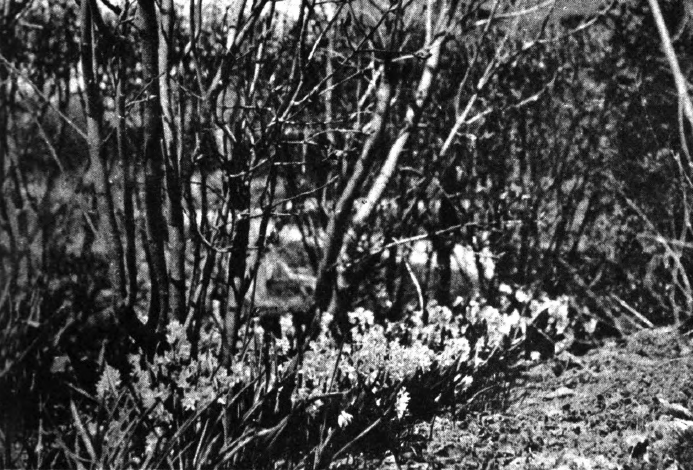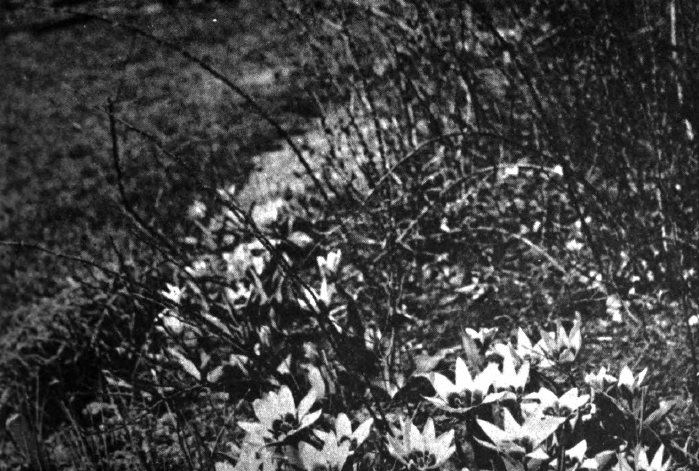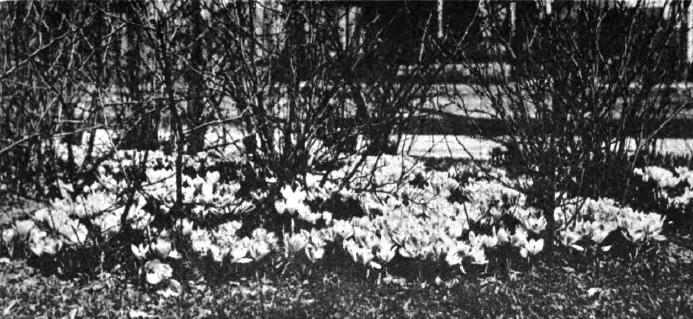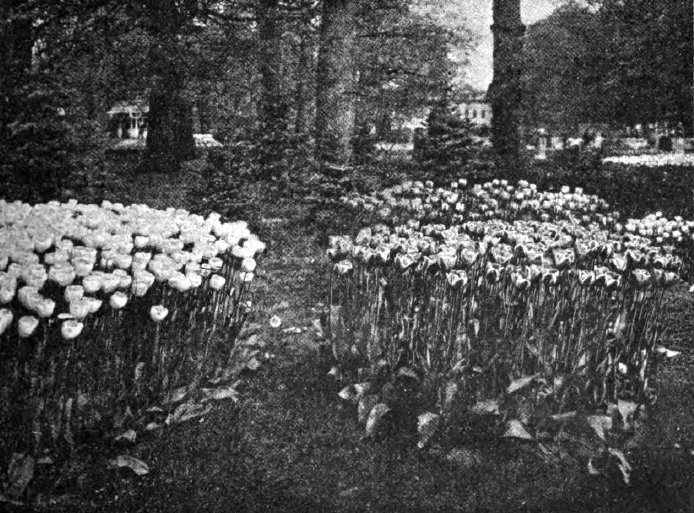| Web
and Book design,
Copyright, Kellscraft Studio 1999-2016 (Return to Web Text-ures) |
 (HOME)
|
|
"O
Spring, I know thee! Seek for sweet surprise
In the young children's eyes. But I have learnt the years, and know the yet Leaf-folded violet. • • • • • • In these young days you meditate your part; I have it all by heart." —
"In Early Spring," ALICE MEYNELL.
COLOR HARMONIES IN THE SPRING GARDEN IN these words, Spring
Flowers,
there is very music. There is a delicious harmony in all of Nature's
colors,
and particularly in the colors of all native spring flowers, as they
appear
with each other in their own environment. If any one doubts what I say,
let him
look at such pictures as are found in Flemwell's "Flowers of the Alpine
Valleys"; let take up Mrs. Allingham's "Happy England"; or let
him in May wander in the nearest woodlot and see a lovely tapestry of
pale
color woven of the pink of spring beauties, the delicate lavenders of
hepatica,
and the faint yellow of the dogtooth violet — thousands (If tiny blooms
crowding each other for space, but all very good. Perhaps, next to the
snowdrop,
crocus is the earliest of the cultivated bulbs to bloom in our wintry
region.
The matter of color mixtures here comes to the fore. I admit this to be
a
question of personal taste; but it is one on which discussion should be
agreeable and fruitful. It happens that I object to a mixture of colors
in
crocus, or, for that matter, in anything. Not long ago a well-known
landscape
gardener, a woman, remarked that a border of mixed Darwin tulips was
one of the
most successful of her many plantings. In such a hand, I am sure this
was so.
If such planting were done exactly as it should be, with sufficient
boldness, a
sure knowledge of what was wanted, and great variety of colors and
tones of
those colors, the result would surely show a tapestry again thrown
along the
earth — a tapestry grander in conception and more glorious in kind than
the one
woven of the tiny blossoms mentioned above. But with the average
gardener a
mixture, so called, is a thing of danger. What more hopeless than a
timid one!
"Be bold, be bold, but not too bold" — Spenserian advice holds/here. To return to crocus.
Awhile ago, in
the borders of this small Michigan place of ours, there was in one
place a most
lovely carpet of colonies of pale-lavender crocus Maximilian, with
grape
hyacinth (Muscari asureum) running in and out in peninsulas, bays, and
islands.
Tall white crocus Reine Blanche, in large numbers, was near by, its
translucent
petals shining in the sun beyond its more delicately colored neighbors.
I believe I have before
expatiated
in these pages on the great beauty of Crocus purpurea, var.
grandiflora,
carpeting large spaces of bare ground beneath shrubbery, principally
used in
connection with great sheets of Scala Sibirica, which blooms so very
little
later than the crocus as to make the two practically simultaneous.
These, in
order to get a telling effect, should be planted by the thousands, and
this, I
beg to assure the reader, is a less serious financial observation than
it
sounds! Hepatica that year
bloomed with Iris
reticulata. As an experiment I arranged the following spring some
groups of
this smart little iris, with hepatica plants threading their way among
the
grasslike leaves of the iris, and near by a few hundreds of Muscari
azureum.
The cool, delicate pinks of the hepatica were in most lovely accord
with the
rich violet of the iris, yet affording a striking contrast in form and
a full
octave apart in depth and height of tone. Is there a valid objection to
thus
using imported and native plants side by side? I know Ruskin would have
hated
it, but the great mid-Victorian man probably never had a chance to see
the
thing well done. You recall what he wrote of English flower gardens: "A flower garden is an
ugly
thing, even when best managed; it is an assembly of unfortunate beings,
pampered and bloated above their natural size; stewed and heated into
diseased
growth; corrupted by evil communication into speckled and inharmonious
colors;
torn from the soil which they loved, and of which they were the spirit
and the
glory, to glare away their term of tormented life among the mixed and
incongruous essences of each other, in earth that they know not, and in
air
that is poison to them." I should like to bring
Mr. Ruskin
back to life again, show him some color achievements in flower
gardening in
England and America to-day, and hear him say, "A new order reigneth." But back to the crocus!
Where drifts
of Crocus purpureus, var. grandiflorus, were blooming under leafless
Japanese
quince, blooming quite by themselves, a fine show of color of the same
order
was had, really only a transition from one key to another, by flinging
along
the ground, planting where they fell, heavy bulbs of hyacinth Lord
Derby. The
full trusses of this superb flower made the most lovely companions for
the
justabout-to-fade crocus. How can I adequately describe the color of
Lord Derby!
Never, no never, in the words of one of the Dutch growers, who calmly
says,
"Porcelain blue, back heavenly blue." May I venture to ask the reader
what impression these words convey to him? To me they are as sounding
brass and
tinkling cymbals. They mean nothing. From my own observation of the
hyacinth, I
should say that its blue, in the early stages of development, has a
certain
iridescent quality which makes it uncommonly interesting, almost
dazzling when
seen beyond the green of the fresh grass of May; and in full bloom it
shines
out with a half-deep tone of purplish blue. Crocus purpureus, var.
grandiflorus, blooms with this hyacinth; the two tones of purple are
distinct
from each other and extremely interesting together. Is, or is not, Puschkinia
little
known? How distinct it is from most of the smaller spring things, and
how
lovely in itself with its tiny bluish-white bells, pencilled with
another
deeper tone of blue! And so rewarding, coming up valiantly year after
year,
without encouragement of the compost or replanting! A little colony of
it is here
shown (page 80) very badly because rather too tightly planted.
Puschkinia could
be associated with Iris reticulata most beautifully; or its slender
bluish
bells would be delightful growing near Tulip Kaufmanniana. The bloom of
all
these bulbous things may be quite confidently expected at the same
time.  PUSCHKINIA BELOW SHRUBS  TULIP KAUFMANNIANA IN BORDER Another
illustration shows practically nothing
but crowds of the fine white crocus Reine Blanche, grown as naturally
as
possible below Pyrus Japonica. Here they dwell calmly and seem to sleep
year
after year, except for the time when. they show their shining faces to
the sun of
April. The most dreaded enemy of the crocus, to my mind, is a wet snow.
The
petals, once soaked and weighted, never recover their beautiful
texture, and
when, one fatal April, as my note-book shows, our hectic climate
brought in one
hour upon these charming but tender flowers rain, hail, and snow, the
wreckage
may be left to the imagination of the tender-hearted. Nothing, to my thinking,
can exceed
for beauty the picture made by the majestic Tulipa Vitellina, with its
beautifully held cups of palest lemon color, when supported by the
lavender
trusses of Phlox divaricata — and the stems of that, in turn, almost
hidden by
the fine Phlox subulata, var. lilacina. Long reaches of these three
flowers
happily planted, or a tiny corner against shrubbery — it matters not
one whit
which — "and then my heart with pleasure fills!" What a wonderful
thing to see below the glowing buds and blossoms of the Japanese quince
clusters of tulip La Merveille or — but not and — tulip Couleur
Cardinal. La
Merveille, with its tremendously telling orange-red hues, puts dash
into the
picture; Couleur Cardinal, sombreness, richness. No one could think for
one
moment of allowing these tulips to appear near each other. Crocus and
early-flowering things below and among the shrubs, to bloom when the
quince is
leafless; tulips toward the grass, to show when tiny points of green
and the
red quince blossoms make a fiery mist above them. The lucky householder or
gardener
who has sometime placed a group of the glorious shrub, Mahonia, on his
ground,
may like a planting which has seemed good to me against the shining
dark-green
of its low branches. Narcissus poetaz, var. Elvira, to bloom with the
lavender
hyacinth Lord Derby or Holbein; with the gay tulip Vermilion Brilliant
near by,
and some groups or colonies of tulip Couleur Cardinal associated with
these.
The fine Darwin tulip Fanny, used with masses of Phlox divaricata and
Phlox
subulata, var. lilacina, below it, is a marvel of color. Mr. Hunt's
description
of Fanny I give: "Clear, rosy pink, with white centre marked blue. Not
a
large flower but one of exquisite color and form." I have never yet
made a
May pilgrimage to Montclair, but I know I should be a wiser gardener if
I
might, for Mr. Hunt's blooming tulips must be worth many a league's
journey. Nothing I have ever had
upon our
small place has given me more spring pleasure than the planting which I
next
describe. A shrub, two tulips, and a primula. The shrub was Spircea
Thunbergii,
with its delicate white sprays of flowers. Below and among these
spireas are
the great tulip La Merveille, orange-scarlet, and the old double Count
of
Leicester, in tawny-orange shades — and before the tulips lay low
masses of the
Munstead primrose. On this primrose, which fares so well with me, I
have
enlarged so often and so volubly that I fear the reader is weary of my
praises.
But' to me it is an essential of the spring. With this primrose, with
the hardy
forget-me-nots, and arabis, the lemon-colored alyssum, the lavender
creeping
phloxes, and with a charming low-growing thing whose name is Lamium
maculatum
(the gray-green leaves have a rather vague whitish marking upon them,
and the
flowers are of a soft mauve — grow tulip Wouverman back of these, I
beg!) — the
most delightful effects may be had. As for tulips, again, the
loveliest
of combinations under lilacs, or immediately before them, would surely
ensue if
groups of tulips Fanny, Carl Becker, Giant, and KOnigin Emma were
planted in
such spots. And speaking of tulips — the ones just mentioned I got of
the Dutch,
the originators of the Darwin and Rembrandt tulips and who thereby have
made
all bulb-growers their eternal debtors. The photograph of tulips which
accompanies these notes shows how exhibition beds may be made beautiful
— it is
a picture of the Haarlem (Holland) Jubilee Show in the spring of 1910. In the illustration, page
86, the
blackish group of tulips in the right-hand middle distance is La Tulipe
Noire —
"the blackest of all the tulips." The circular group in the centre
distance is Edmee, a bright cherry-rose color, also Darwin; and at the
extreme
left L'Ingenue, a fine white Darwin, slightly suffused with pale rose. Mr. Krelage gave last
autumn to one
of his English friends a list of the Darwin tulips he considers the
best. These
are the ones: Clara Butt, salmon-pink; Crepuscule, pinky lilac; Faust,
deep
violet; Giant, deep purplish-crimson; La Candeur, ivory-white; La
Tristesse,
slaty blue; Madame Krelage, rosy pink; Margaret, soft pink, almost
blush; Mr.
Farncombe Sanders, rosy crimson; Prince of the Netherlands,
cerise-carmine;
Raphael, purplish violet; and Haarlem, a giant salmony orange-red. Five
of
these I have grown. The man to whom this list was given, a
distinguished judge
of flowers, comments on the evident partiality of Mr. Krelage for the
rich
deep-purples, as shown by these choices of his own. Last spring Miss Jekyll
wrote of her
pleasure in some beautiful varieties of tulips, Darwins and Cottage
both, sent
her as cut blooms by a well-known grower. And I was so charmed with her
description
of these, especially with what she said of the purple and bronze tones
of some
of them, that I cleared out a lot of shrubbery to make room, and
planted last
fall the following groups: Ewbank and Morales together, Faust, Grand
Monarque,
Purple Perfection, and D. T. Fish; Bronze King, Bronze Queen, Golden
Bronze,
Dom Pedro, Louis XIV; Salmon Prince, Orange King, Panorama, Orange
Globe, and
La Merveille. I am not a collector; but
how
readily, save for one reason, could I become one, in ten different
directions
in the world of flowers! Tulips should be one of my choices; the
narcissus
another; no one could pass by the iris. The collecting of tulips is, I
fancy,
simple beside, say, that of daffodils. The varieties of the daffodil
are so
many, the classes not as yet quite clearly defined; while the tulip is
simplicity itself, except when it comes to tulip species — there the
botanist
comes to the front and no unlearned ones need apply. Tulips are
unfailing,
certain to appear. No coaxing is necessary, nor do they require special
positions. They may, for instance, grow among peonies; they are
delightful
among grapes. While the narcissus may not flourish among peonies,
because of
the amount of manure needed by the latter, tulips come gloriously
forth. The question
was put to me some time since by Doctor Miller as to the probability of
injury
to or failure of narcissus when planted among peonies, on account of
the amount
of manure generally used among such roots — the statement made
originally, I
believe, by some English writer. May I give here the opinion of an
English
authority on daffodils in his own words?  CROCUS MONT BLANC  DARWIN TULIPS AT THE HAARLEM (HOLLAND) JUBILEE SHOW, 1910 "As to daffodils among
peonies
— well, if you don't get manure (new) among their roots, and only
top-dress
with farmyard or stable manure, using bonemeal underground, I think
many
daffodils would do very well; but you should try them from more places
than one
when you buy. Like humans and others, a rich diet coming on top of a
long-drawn-out poor one upsets matters." Crocus-collecting,
judging from what
Mr. E. Augustus Bowles writes of it, must have charms indeed. I confess
to the
germ of the fever in the shape of several of Mr. Bowles's delightfully
readable
articles safely put away in a letter-file. Each time I take these out
to reread
them, I grow a little weaker; and by next July when fresh lists of
crocus
species lay their fatal hand upon me, I expect to be a
crocus-bed-ridden
invalid indeed! |